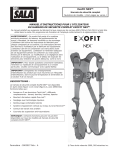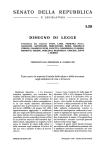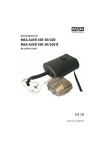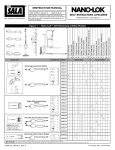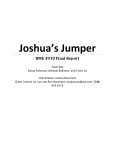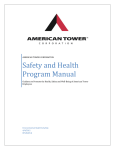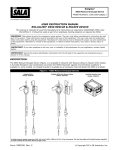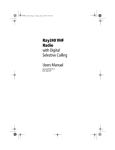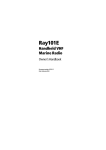Download ExoFit NEX™ USER INSTRUCTION MANUAL EXOFIT
Transcript
ExoFit NEX™ Full Body Harness Model Numbers: (See back pages.) USER INSTRUCTION MANUAL EXOFIT NEX™ FULL BODY HARNESS This manual is intended to meet the Manufacturer’s Instructions as required by ANSI Z359 and CSA 259.10 and should be used as part of an employee training program as required by OSHA WARNING: This product is part of a personal fall arrest, restraint, work positioning, climbing, controlled descent, or rescue system. The user must follow the manufacturer’s instructions for each component of the system. These instructions must be provided to the user of this equipment. The user must read and understand these instructions before using this equipment. Manufacturer’s instructions must be followed for proper use and maintenance of this equipment. Alterations or misuse of this product or failure to follow instructions may result in serious injury or death. IMPORTANT: If you have questions on the use, care, or suitability of this equipment for your application, contact Capital Safety. IMPORTANT: Record the product identification information from the ID label in the inspection and maintenance log in Section 9 of this manual. DESCRIPTIONS: The ExoFit NEX™ Full Body Harness is available in Vest (Figure 1) and Cross-Over (Figure 2) styles configured with a variety of features including the following: • Tech-Lite™ Aluminum D-Rings - Varied Locations: Front, Back, Hips, Shoulders • Duo-Lok™ Quick Connect Buckles • Repel Technology Webbing • Hybrid Comfort Padding • Revolver™ Vertical Torso Adjusters • Tongue Buckle Body Belt • Suspension Trauma Straps NOTE: Some features may not be available on all models of the ExoFit NEX™ Full Body Harness. Form: 5903027 Rev: D © Copyright 2014, Capital Safety. Figure 1 - ExoFit NEX™ Vest Style Full Body Harness A H B C D E F B I I G A. Shoulder Strap w/Hybrid Padding B. Duo-Lok™ Quick Connect Buckle C. Chest Strap D. Hybrid Chest Pad with i-Safe™ RFID Tag & Labels E. Revolver™ Torso Adjustor F. Tech-Lite™ Side D-Ring G. Leg Strap H. Tech-Lite™ Dorsal D-Ring I. Trauma Strap Figure 2 - ExoFit NEX™ Cross-Over Style Full Body Harness A G B C D F E A. Shoulder Strap w/Hybrid Padding B. Revolver™ Adjustor C. Hybrid Chest Pad with i-Safe™ RFID Tag & Labels D. Tech-Lite™ Front D-Ring E. Duo-Lok™ Quick Connect Buckle F. Trauma Strap G. Tech-Lite™ Dorsal D-Ring 2 1.0 APPLICATION 1.1 PURPOSE: The DBI-SALA ExoFit NEX™™ Full Body Harness (Figure 1 and Figure 2) should be used as a component in personal fall arrest, restraint, work positioning, climbing, controlled descent, or rescue systems (see Table 1). ExoFit NEX™ Harnesses included in this manual are full body harnesses and meet ANSI Z359.1, OSHA, and CSA Z259.10 requirements. See Figure 3 for application illustrations. WARNING: Working at height has inherent risks. Some risks are noted here but are not limited to: falling, suspension/prolonged suspension, striking objects, and unconsciousness. In the event of a fall arrest and/or subsequent rescue (emergency) situation, some personal medical conditions may affect your safety. Medical conditions identified as risky for this type of activity include, but are not limited to: heart disease, high blood pressure, vertigo, epilepsy, drug or alcohol dependence, psychiatric illness, impaired limb function and balance issues. We recommend that your employer/physician determine if you are fit to handle normal and emergency use of this equipment. Table 1 - ExoFit NEX™ Full Body Harness Applications Application Description Class A The full body harness is used as a component of a personal fall arrest system. Personal fall arrest systems typically include a full body harness and a connecting subsystem (energy absorbing lanyard). Maximum arresting force must not exceed 1,800 lbs (8 kN). For fall arrest applications connect the fall arrest subsystem (example: lanyard, SRL, energy absorber, etc.) to the D-ring or attachment element on your back, between your shoulder blades. Controlled Descent Class D For controlled descent applications, harnesses equipped with a single sternal level D-ring, one or two frontal mounted D-rings, or a pair of connectors originating below the waist (such as a seat sling) may be used for connection to a descender or evacuation system (reference in Z259.10 in Canada). Rescue Class E The full body harness is used as a component of a rescue system. Rescue systems are configured depending on the type of rescue. For limited access (confined space) applications, harnesses equipped with D-rings on the shoulders may be used for entry and egress into confined spaces where worker profile is an issue. Ladder Climbing Class L The full body harness is used as a component of a climbing system to prevent the user from falling when climbing a ladder or other climbing structure. Climbing systems typically include a full body harness, vertical cable or rail attached to the structure, and climbing sleeve. For ladder climbing applications, harnesses equipped with a frontal D-ring in the sternal location may be used for fall arrest on fixed ladder climbing systems. These are defined in CSA Z259.2.1 in Canada and ANSI A14.3 in the United States. Work Positioning Class P The full body harness is used as a component of a work positioning system to support the user at a work position. Work positioning systems typically include a full body harness, positioning lanyard, and a back-up personal fall arrest system. For work positioning applications, connect the work positioning subsystem (example: lanyard, Y-lanyard, etc.) to the lower (hip level) side or belt mounted work positioning attachment anchorage elements (D-rings). Never use these connection points for fall arrest. Restraint 1.2 CSA Class Personal Fall Arrest None The full body harness is used as a component of a restraint system to prevent the user from reaching a fall hazard. Restraint systems typically include a full body harness and a lanyard or restraint line. STANDARDS: Refer to local, state, and federal (OSHA) requirements governing occupational safety for additional information regarding Personal Fall Arrest Systems. Refer to the following national standards on fall protection: ANSI Z359.0 Definitions and Nomenclature Used for Fall Protection and Fall Arrest ANSI Z359.1 Safety Requirements for Personal Fall Arrest Systems, Subsystems, and Components ANSI Z359.2 Minimum Requirements for a Comprehensive Managed Fall Protection Program ANSI Z359.3 Safety Requirements for Positioning and Travel Restraint Systems ANSI Z359.4 Safety Requirements for Assisted-Rescue and Self-Rescue Systems, Subsystems, and Components ANSI A10.32 Fall Protection Systems for Construction and Demolitions CSA Z259.10 Full Body Harnesses ASTM F887-2011 Standard Specifications for Personal Climbing Equipment 3 Figure 3 - Applications 1 Fall Arrest 2 Restraint 3 Ladder Climbing 4a Work Positioning 4b Work Positioning or Controlled Descent, with Seat Sling 4c Work Positioning, with Seat Sling 4d Work Positioning, with Seat Sling Tower Climbing A Anchorage B Anchorage Connector C Connecting Subsystem (SRL shown) D Full Body Harness E Restraint Lanyard F Backup Fall Arrest System G Cable Sleeve I Cable J Seat Sling K H B D I A D 2 1 A A B A B F F 3 B E A F K E A E E D D D D B Tower Structure J J 4a 1.3 G E C Ladder H A B A 4b J 4c 4d TRAINING: This equipment is intended to be used by persons trained in its correct application and use. It is the responsibility of the user to assure they are familiar with these instructions and are trained in the correct care and use of this equipment. Users must also be aware of the operating characteristics, application limits, and the consequences of improper use. 2.0 SYSTEM LIMITATIONS & REQUIREMENTS Consider the following limitations/requirements prior to installing or using this equipment: 2.1 CAPACITY: ExoFit NEX™ Full Body Harnesses are designed for use by persons with a combined weight (clothing, tools, etc.) of no more than 420 lbs. (191 kg) per OSHA, 310 lbs. (141 kg) per ANSI Z359.1, or 352 lbs. (160 kg) per CSA Z259.10-06. Make sure all of the components in your system are rated to a capacity appropriate to your application. 2.2 FREE FALL: Personal fall arrest systems used with this equipment must be rigged to limit the free fall to 6 feet (1.8 M) per ANSI Z359.1 (see Section 7.1). Restraint systems must be rigged so that no vertical free fall is possible. Work positioning systems must be rigged so that free fall is limited to 2 feet (.6 m) or less. Personnel riding systems must be rigged so that no vertical free fall is possible. Climbing systems must be rigged so that free fall is limited to 18 in. (.46 cm) or less. Rescue systems must be rigged so that no vertical free fall is possible. See subsystem manufacturer’s instructions for more information. 2.3 FALL CLEARANCE: Figure 4 illustrates fall clearance requirements. There must be sufficient clearance below the user to allow the system to arrest a fall before the user strikes the ground or other obstruction. Clearance required is dependent on the following factors: • • • Elevation of Anchorage Deceleration Distance Worker Height • • • Connecting Subsystem Length Free Fall Distance Movement of Harness Attachment Element 4 Figure 4 - Fall Clearance (Lanyards) Figure 5 - Swing Falls RD = LL + DD + HH + C RD Required Fall Clearance Distance LL Length of Lanyard (Specified on labeling) DD Deceleration Distance = 4 ft (1.2 m) except: • for ANSI/OSHA Lanyards with Free Fall greater than 6 ft (1.8 m) up to 12 ft (3.7 m), or user weights greater than 310 lbs (141 kg) up to 420 lbs (191 kg); add 1 ft (0.3 m): DD = 5 ft (1.5 m) • for CSA E6 Lanyards, add 1.7 ft. (0.5 m): DD = 5.7 ft (1.7 m) HH Height of Suspended Worker C Safety Factor = 1.5 ft (0.5 m) (Factors in D-Ring Slide and Harness Stretch.) LL RD DD HH Example: Assuming a 6 ft (1.8 m) tall user with a typical 6 ft (1.8 m) lanyard with 6 ft (1.8 m) Free Fall, Fall Clearance calculation would be as follows: RD = LL + DD + HH + C RD = 6 ft + 4 ft + 6 ft + 1.5 ft = 17.5 ft RD = 1.8 m + 1.2 m + 1.8 m + 0.5 m = 5.3 m C 2.4 SWING FALLS: Swing falls occur when the anchorage point is not directly above the point where a fall occurs. The force of striking an object in a swing fall may cause serious injury or death. Minimize swing falls by working as close to the anchorage point as possible. Do not permit a swing fall if injury could occur. Swing falls will significantly increase the clearance required when a self-retracting lifeline or other variable length connecting subsystem is used. 2.5 EXTENDED SUSPENSION: A full body harness is not intended for use in extended suspension applications. If the user is going to be suspended for an extended length of time it is recommended that some form of seat support be used. DBI-SALA recommends a seat board, suspension work seat, seat sling, or a boatswain chair. Contact Capital Safety for more information on these items. 2.6 ENVIRONMENTAL HAZARDS: Use of this equipment in areas with environmental hazards may require additional precautions to prevent injury to the user or damage to the equipment. Hazards may include, but are not limited to: heat, chemicals, corrosive environments, high voltage power lines, gases, moving machinery and sharp edges. 2.7 COMPATIBILITY OF COMPONENTS: Unless otherwise noted, DBI-SALA equipment is designed for use with DBI-SALA approved components and subsystems only. Substitutions or replacements made with non approved components or subsystems may jeopardize compatibility of equipment and may affect safety and reliability of the complete system. 2.8 COMPATIBILITY OF CONNECTORS: Connectors are considered to be compatible with connecting elements when they have been designed to work together in such a way that their sizes and shapes do not cause their gate mechanisms to inadvertently open regardless of how they become oriented. Connectors (hooks, carabiners, and D-rings) must be capable of supporting at least 5,000 lbs. (22 kN). Connectors must be compatible with the anchorage or other system components. Do not use equipment that is not compatible. Non-compatible connectors may unintentionally disengage (see Figure 6). Connectors must be compatible in size, shape, and strength. Self-locking snap hooks and carabiners are required by ANSI Z359.1 and OSHA. 5 2.9 MAKING CONNECTIONS: Use only self-locking snap hooks and carabiners with this equipment. Only use connectors that are suitable to each application. Ensure all connections are compatible in size, shape and strength. Do not use equipment that is not compatible. Ensure all connectors are fully closed and locked. DBI-SALA connectors (snap hooks and carabiners) are designed to be used only as specified in each product’s user’s instructions. See Figure 7 for illustration of the inappropriate connections stated below. DBISALA snap hooks and carabiners should not be connected: A. To a D-ring to which another connector is attached. B. In a manner that would result in a load on the gate. C. In a false engagement, where features that protrude from the snap hook or carabiner catch on the anchor and without visual confirmation seems to be fully engaged to the anchor point. D. To each other. E. Directly to webbing or rope lanyard or tie-back (unless the manufacturer’s instructions for both the lanyard and connector specifically allow such a connection). F. To any object which is shaped or dimensioned such that the snap hook or carabiner will not close and lock, or that roll-out could occur. G. In a manner that does not allow the connector to align with the fall arrest device (i.e., lanyard) while under load. NOTE: Other than 3,600 lb. (16 kN) gated hooks, large throat opening snap hooks should not be connected to standard size D-rings or similar objects which will result in a load on the gate if the hook or D-ring twists or rotates. Large throat snap hooks are designed for use on fixed structural elements such as rebar or cross members that are not shaped in a way that can capture the gate of the hook. Other Restrictions: • Do not make connections where the hook locking mechanism can come into contact with a structural member or other equipment and potentially release the hook. • Do not connect a snap hook into a loop or thimble of a wire rope or attach in any way to a slack wire rope. • The snap hook must be free to align with the applied load as intended (regardless of the size or shape of the mating connector). • A carabiner may be used to connect to a single or pair of soft loops on a body support such as a body belt or full body harness, provided the carabiner can fully close and lock. This type of connection is not allowed for snap hooks. • A carabiner may be connected to a loop or ring connector that is already occupied by a choker style connector. This type of connection is not allowed for snap hooks. Figure 6 - Unintentional Disengagement (Rollout) Figure 7 - Inappropriate Connections If the connecting element to which a snap hook (shown) or carabiner attaches is undersized or irregular in shape, a situation could occur where the connecting element applies a force to the gate of the snap hook or carabiner. This force may cause the gate (of either a selflocking or a non-locking snap hook) to open, allowing the snap hook or carabiner to disengage from the connecting point. Small ring or other non-compatibly shaped element 1. Force is applied to the Snap Hook. 2. The Gate presses against the Connecting Ring. 3. The Gate opens allowing the Snap Hook to slip off. 6 2.10 CONNECTING SUBSYSTEMS: Connecting subsystems (self-retracting lifeline, lanyard, rope grab and lifeline, cable sleeve) must be suitable for your application (see Table 1). See subsystem manufacturer’s instructions for more information. Some harness models have web loop connection points. Do not use snap hooks to connect to web loops. Use a self-locking carabiner to connect to a web loop. Ensure the carabiner cannot cross-gate load (load against the gate rather than along the backbone of the carabiner). Some lanyards are designed to choke onto a web loop to provide a compatible connection. See Figure 8. Lanyards may be sewn directly to the web loop forming a permanent connection. Do not make multiple connections onto one web loop, unless choking two lanyards onto a properly sized web loop. Figure 8 - Web Loop Connection 1. Insert Lanyard Web Loop (A) through Web Loop or D-ring on harness (B). 2. Insert opposite end of Lanyard through the Lanyard Web Loop. 3. 1 B A Pull the Lanyard through the connecting Web Loop to secure. 2 3 2.11 ANCHORAGE & ANCHORAGE STRENGTH: Anchorage and anchorage strength requirements are dependent on the full body harness application (see Figure 3). In accordance with ANSI Z359.1, anchorages selected for Fall Arrest Systems must meet the anchorage strength requirements defined in Table 2. Table 2 - Anchorage Strength Requirements Fall Arrest1 Non-Certified Anchorages: 5,000 lbs (22.2 kN) Certified Anchorages : 2 times the Maximum Arresting Force for Certified Anchorages 2 Restraint1 Work Positioning1 Rescue1 Climbing Non-Certified Anchorages 1,000 (4,5 kN) Certified Anchorages2: 2 times the foreseeable force for certified anchorages. Non-Certified Anchorages 3,000 lbs (13.3 kN) Certified Anchorages2: 2 times the foreseeable force for certified anchorages. Non-Certified Anchorages 3,000 lbs (13.3 kN) Certified Anchorages2: 5 times the foreseeable force for certified anchorages. The structure to which a climbing system is attached must sustain the loads required by that particular system. See the instructions for the climbing system for requirements. 1 Multiple Systems: When more than one of the defined system is attached to an anchorage, the strength defined for Non-Certified or Certified anchorages shall be multiplied by the number of systems attached to the anchorage. 2 Certified Anchorage: An anchorage for fall arrest, positioning, restraint, or rescue systems that a qualified person certifies to be capable of supporting the potential fall forces that could be encountered during a fall or that meet the criteria for a certified anchorage prescribed in this standard. 7 3.0 DONNING AND USE WARNING: Do not alter or intentionally misuse this equipment. Consult Capital Safety when using this equipment in combination with components or subsystems other than those described in this manual. Some subsystem and component combinations may interfere with the operation of this equipment. Use caution when using this equipment around moving machinery, electrical and chemical hazards, and sharp edges. 3.1 BEFORE EACH USE: Before each use of this equipment inspect the ExoFit NEX™ Full Body Harness according to Section 5 of this manual. 3.2 PLANNING: Plan your system before use. Consider all factors that will affect your safety during use of this equipment. Consider the following aspects when planning your system: 3.3 • ANCHORAGE: Select an anchorage that meets the anchorage requirements specified in Section 2. • SHARP EDGES: Avoid working where system components may be in contact with, come in contact with, or abrade against, unprotected sharp edges. • AFTER A FALL: Any equipment which has been subjected to the forces of arresting a fall, or exhibits damage consistent with the effect of fall arrest forces as described in Section 5, must be removed from service immediately and destroyed by the user, the rescuer1, or an authorized person2. • RESCUE: The employer must have a rescue plan when using this equipment. The employer must have the ability to perform a rescue quickly and safely. DONNING AND FITTING THE HARNESS: The ExoFit NEX™ Full Body Harness is available in Vest (Figure 1) and Cross-Over (Figure 10) styles. Donning procedures will vary with the harness style. WARNING: Do not alter or intentionally misuse this equipment. Consult Capital Safety when using this equipment in combination with components or subsystems other than those described in this manual. Some subsystem and component combinations may interfere with the operation of this equipment. Use caution when using this equipment around moving machinery, electrical and chemical hazards, and sharp edges. Figure 9 - Vest Style Harness Figure 10 - Cross-Over Style Harness A A A. Belt Loops A. Belt Loops 1 Rescuer: Person or persons other than the rescue subject acting to perform an assisted rescue by operation of a rescue system. 2 Authorized Person: A person assigned by the employer to perform duties at a location where the person will be exposed to a fall hazard (otherwise referred to as “user” for the purpose of these instructions). 8 A. EXOFIT NEX™ VEST STYLE FULL BODY HARNESS: The ExoFit NEX™ Vest Style Harness incorporates loops for a removable waist belt (see Figure 9). The belt can be installed through the two loops in the harness located in the lower back shoulder straps. The belt will pass through the harness just below the padded area. The hip pad, if used, is secured to the belt by passing the belt through the hip pad loops. Don the Vest Style Full Body Harness per the following steps and corresponding images in Figure 11: Step 1. Locate back D-ring held in position by the D-ring pad; lift up harness and hold by this D-ring. Ensure the straps are not twisted. Step 2. Grasp the shoulder straps and slip the harness onto one arm. The D-ring will be located on your back side. Ensure that the straps are not tangled and hang freely. Slip your free arm into the harness and position the shoulder straps on top of your shoulder. Ensure that the straps are not tangled and hang freely. The chest strap, with quick connect buckle, will be positioned on the front side when worn properly. Step 3. Reach between your legs and grasp the gray leg strap on your left side. Bring the strap up between your legs and connect it by inserting the tab of the buckle into receptor of quick connect buckle on the left side as shown in Figure 11. You will hear a click when the tab engages properly. Connect the right leg strap using the same procedure. To adjust the leg straps, unlock the webbing lock on the quick connect buckle and pull on the strap. A plastic end keeper on the end of the strap will stop it from pulling completely out of the buckle. When the strap is properly adjusted, lock the webbing lock. To release the buckle, press the silver-colored tabs on the buckle towards each other with one hand, while pulling on the tab portion of the buckle with the other hand. NOTE: Locking and unlocking the webbing lock prevents or allows the strap to slide between the sliding bar and slot on the female end of the quick connect buckle. It does not control engagement or disengagement of the buckle ends and will not affect the buckle connection in the event of a fall. Step 4. Attach the chest strap by inserting the tab of the buckle into the receptor of the quick connect buckle. You will hear a click when the tab engages properly. The chest strap should be 6 in. (15 cm) down from the top of your shoulders. Pass excess strap through the loop keepers. To adjust the chest strap, unlock the webbing lock on the quick connect buckle and pull on the strap. A plastic end keeper on the end of the strap will stop it from pulling completely out of the buckle. When the strap is properly adjusted, lock the webbing lock. To release the buckle, press the silver-colored tabs on the buckle toward each other with one hand, while pulling on the tab portion of the buckle with the other hand. Step 5. Adjust shoulder straps to a snug fit with the Vertical Torso Adjusters (see Figure 11): Left and right sides of shoulder straps should be adjusted to the same length and the chest strap should be centered on your lower chest, 6 in. (15 cm) down from shoulder. The front D-ring on the vest style harness is moved up or down by adjusting the shoulder straps and leg straps. Center the back D-ring between your shoulder blades. Note: On applicable models, the back (dorsal) D-ring can be repositioned up or down as needed for a correct fit. Adjust leg straps to a snug fit. At least 3 in. (8 cm) of webbing must extend past the buckle on the leg straps. Adjust the waist belt (if present). 9 Figure 11 - Donning the ExoFit NEX™ Vest Style Full Body Harness Step 1 Step 2 Step 3 Duo-Lok™ Quick Connect Buckles Connection: Connect buckle ends by inserting the tab into the receptor until a click is heard. Strap Adjustment: Rotate Webbing Lock to unlocked position . Pull strap to adjust. Rotate Webbing Lock to locked position . NOTE: The Webbing Lock does not control engagement or disengagement of the buckle ends. Revolver™ Vertical Torso Adjusters Right To Tighten: Turn Ratchet Knob in direction A. Left To Loosen: Pull Ratchet Knob out and turn in direction B. A Step 4 B NOTE: After adjustment, tug upwards on the shoulder straps to ensure that each adjustor is locked in place. 10 A Step 5 B B. EXOFIT NEX™ CROSS-OVER STYLE FULL BODY HARNESS: The ExoFit NEX™ Cross-Over Style Harness incorporates loops for a removable waist belt. The belt can be installed through the two loops in the harness located in the lower back shoulder straps (see Figure 10). The belt will pass through the harness just below the padded area. The hip pad, if used, is secured to the belt by passing the belt through the hip pad loops. Don the Cross-Over Style Full Body Harness per the following steps and corresponding images in Figure 12: Step 1. Locate the back D-ring held in position by the D-ring pad; lift up the harness and hold by this D-ring. Ensure the straps are not twisted. Step 2. Grasp the shoulder straps between the back and front D-ring and slip the harness over your head from the left side. Position the shoulder straps on top of your shoulders. Ensure that the straps are not tangled and hang freely. The D-ring will be positioned on your back when worn properly. Step 3. Grasp the tab of the buckle located at your right hip and insert it into the receptor of the quick connect buckle (see Figure 12). You will hear a click when the tab engages properly. Step 4. Reach between your legs and grasp the gray leg strap on your left side. Bring the strap up between your legs and insert the tab of the buckle into the receptor of the buckle on the left side as shown in Figure 12. You will hear a click when the tab engages properly. Connect the right leg strap using the same procedure. To adjust the leg straps, unlock the webbing lock on the quick connect buckle and pull on the strap. A plastic end keeper on the end of the strap will stop it from pulling completely out of the buckle. When the strap is properly adjusted, lock the webbing lock. To release the buckle, press the silver-colored tabs on the buckle towards each other with one hand, while pulling on the tab portion of the buckle with the other hand. NOTE: Locking and unlocking the webbing lock prevents or allows the strap to slide between the sliding bar and slot on the female end of the quick connect buckle. It does not control engagement or disengagement of the buckle ends and will not affect the buckle connection in the event of a fall. Step 5. Adjust shoulder straps to a snug fit with the Vertical Torso Adjusters (see Figure 12): Left and right sides of the shoulder straps should be adjusted to the same length and the front D-ring should be centered on your lower chest. The back D-ring should be centered between your shoulder blades. Note: On ExoFit XP models, the back (dorsal) D-ring can be repositioned up or down as needed for a correct fit. Adjust the leg straps to a snug fit. At least 3 in. (8 cm) of webbing must extend past the buckle on the leg straps. Adjust the waist belt (if present). 3.4 USE OF FALL ARREST D-RING OR ATTACHMENT ELEMENT: For fall arrest applications connect to the D-ring or attachment element on your back, between your shoulder blades. Side D-rings, if present, are for positioning or restraint applications only. Front D-ring, if present, is for ladder climbing, positioning, or other applications with a limited free fall not exceeding 2 feet (0.6 m) with a 900 MAF requirement. For rescue, back, shoulder, or front D-rings may be used. D-rings on seat sling are for work positioning or personnel riding. 3.5 MAKING CONNECTIONS: When using a hook to connect to an anchorage or when coupling components of the system together, ensure roll-out cannot occur. Roll-out occurs when interference between the hook and mating connector causes the hook gate to unintentionally open and release. Self-locking snap hooks and carabiners should be used to reduce the possibility of roll-out. Do not use hooks or connectors that will not completely close over the attachment object. See subsystem manufacturer’s instructions for more information on making connections. 3.6 CONNECTING SYSTEM COMPONENTS: After properly fitting the full body harness, the user may then connect to other system components. Follow the guidelines in Section 3.4 when selecting the correct attachment element. 11 Figure 12 - Donning the ExoFit NEX™ Cross-Over Style Full Body Harness Step 1 Step 2 Step 3 Duo-Lok™ Quick Connect Buckles Connection: Connect buckle ends by inserting the tab into the receptor until a click is heard. Strap Adjustment: Rotate Webbing Lock to unlocked position . Pull strap to adjust. Rotate Webbing Lock to locked position . NOTE: The Webbing Lock does not control engagement or disengagement of the buckle ends. Revolver™ Vertical Torso Adjusters To Tighten: Turn Ratchet Knob in direction A. Left To Loosen: Pull Ratchet Knob out and turn in direction B. Step 4 A NOTE: After adjustment, tug upwards on the shoulder straps to ensure that each adjustor is locked in place. Step 5 B 12 3.7 SUSPENSION TRAUMA STRAP: The ExoFit NEX™ Full Body Harness is equipped with a Suspension Trauma Strap (Figure 13) to help prolong allowable suspension time in the event of a fall from height. It should only be used in situations where a fall has occurred or for training. To use the Suspension Trauma Strap: Step 1. Unzip the Trauma Strap Pouch on each hip of the harness and deploy the Suspension Straps (Figure 13A). Step 2. Raise the ends of the straps to access the hook and loops. Insert the hook into the loop that provides the desired strap length. Step 3. Lower the Suspension Strap and step onto the strap to alleviate pressure of the harness leg straps on the legs (Figure 13B). Adjust the hook/loop combination for optimal comfort. Figure 13 - Suspension Trauma Straps A B WARNING: Maintain an upright position following suspension. Do not lay down. Seek medical attention following a suspension. 3.8 EXOFIT NEX GLOBAL WIND ENERGY HARNESS MODEL REPLACEABLE LUMBAR PROTECTOR: The Lumbar Protector (A) can be replaced in the field when worn or damaged. (See Figure 14) Figure 14 - Replaceable Lumbar Protector A B Place the ExoFit harness on a flat surface. Pull the hip belt (B) completely out of the harness to free the worn/damaged Lumbar Protector (A) and tool loops (D, if installed). To install the replacement Lumbar Protector: Step 1. Step 2. Reinsert the hip belt through the left D-Ring (C), the end of the first tool loop (D, if installed), belt loops (E) and (F), and the end of the tool loop (D). D D C E Insert the hip belt through the replacement Lumbar Protector (G), the second tool loop (H, if installed), the next two belt loops (I) and (K), the end of the tool loop (H) and the right D-Ring. G F I H K H Completed installation of replacement Lumbar Protector. 13 4.0 TRAINING It is the responsibility of the purchaser and the user of this equipment to assure that they understand these instructions and are trained in the correct care and use of this equipment. They must also be aware of the operating characteristics, application limits, and the consequences of improper use of this equipment. IMPORTANT: Training must be conducted without exposing the user to a fall hazard. Training should be repeated on a periodic basis. 5.0 INSPECTION 5.1 i-Safe™ RFID TAG: The i-Safe™ RFID tag on the ExoFit NEX™ Harness (see “Figure 15 i-Safe™ RFID Tag”) can be used in conjunction with the i-Safe handheld reading device and the web based portal to simplify inspection and inventory control and provide records for your fall protection equipment. Figure 15 i-Safe™ RFID Tag A Wrap-Around Cover B i-Safe™ RFID Tag C Product Labels A B C 5.2 FREQUENCY: Before each use inspect the full body harness according to Section 5.3. The harness must be inspected by a competent person3, other than the user, at least annually. Record the results of each formal inspection in the inspection and maintenance log in section Section 9, or use the i-Safe™ inspection web portal to maintain your inspection records. If you are a first-time user, contact a Customer Service representative in the US at 800-328-6146 or in Canada at 800-387-7484 or if you have already registered, go to: www.capitalsafety.com/isafe. Follow instructions provided with your i-Safe handheld reader or on the web portal to transfer your data to your web log. IMPORTANT: If the full body harness has been subjected to fall arrest or impact forces it must be immediately removed from service and destroyed. IMPORTANT: Extreme working conditions (harsh environments, prolonged use, etc.) may require increasing the frequency of inspections. 5.3 INSPECTION: Inspect the ExoFit NEX™ Full Body Harness as follows: Step 1. Inspect harness hardware (buckles, D-rings, pads, loop keepers, vertical torso adjusters): These items must not be damaged, broken, distorted, and must be free of sharp edges, burrs, cracks, worn parts, or corrosion. PVC coated hardware must be free of cuts, rips, tears, holes, etc. in the coating to ensure non-conductivity. Ensure that release tabs on buckles work freely and that a click is heard when the buckle engages. Inspect vertical torso adjusters for proper operation. Ratchet knobs should turn with ease in a clockwise direction and should only turn counterclockwise when the knob is pulled out. Step 2. Inspect webbing: Material must be free of frayed, cut, or broken fibers. Check for tears, abrasions, mold, burns, or discoloration. Inspect stitching; check for pulled or cut stitches. Broken stitches may be an indication that the harness has been impact loaded and must be removed from service. When performing the annual formal inspection, unsnap and open the back pad to facilitate inspection of the webbing. Step 3. Inspect the labels: All labels should be present and fully legible (see Section 8). Step 4. Inspect system components and subsystems: Inspect each system component or subsystem according to manufacturer’s instructions. 3 Competent Person: One who is capable of identifying existing and predictable hazards in the surroundings or working conditions which are unsanitary, hazardous, or dangerous to employees, and who has authorization to take prompt corrective measures to eliminate them. 14 Step 5. Record inspection data: Record the inspection date and results in the Inspection and Maintenance Log (see Section 9). Step 6. Inspect the Stitched Impact Indicator: The stitched impact indicator is a section of webbing that is lapped back on itself and secured with a specific stitch pattern holding the lap (see Figure 16). The stitch pattern is designed to release when the harness arrests a fall or has been subjected to an equivalent force If the impact indicator has been activated the harness must be removed from service and destroyed. Step 7. Inspect Suspension Trauma Straps: Check the trauma strap pouches for damage and secure connection to the harness. Unzip the trauma strap pouch on each hip of the harness and inspect suspension trauma straps. Webbing and pouch material must be free of frayed, cut, or broken fibers. Check for tears, abrasions, mold, burns, discoloration, or knots. Verify that one pouch is marked ‘Hook’ and the other marked ‘loop’. IMPORTANT: If inspection reveals a defective condition, remove the unit from service immediately and destroy it. NOTE: Only DBI-SALA or parties authorized in writing may make repairs to this equipment. Figure 16- Stitched Impact Indicator A. Stitched Impact Indicator A A 6.0 MAINTENANCE, SERVICING, AND STORAGE 6.1 WASHING INSTRUCTIONS: Washing procedures for the ExoFit NEX™ Full Body Harness are as follows: Step 1. Spot clean the ExoFit NEX™ full body harness with water and a mild soap solution. IMPORTANT: Use a bleach-free detergent when washing the harness and pads. Fabric softener or dryer sheets SHOULD NOT be used when laundering and drying the harness and pads. Step 2. Water temperature for wash and rinse must not exceed 160° F (70° C). Step 3. The harness and pads may be air dried or tumble dried on low heat not exceeding 200° F (90° C). NOTE: More information on cleaning is available from Capital Safety. If you have questions concerning the condition of your harness, or have any doubt about putting it into service, contact Capital Safety. 6.2 ADDITIONAL MAINTENANCE AND SERVICING: Additional maintenance and servicing procedures must be completed by a factory authorized service center. Authorization must be in writing. Do not attempt to disassemble the unit. 6.3 STORAGE: Store the ExoFit NEX™ Full Body Harness in a cool, dry, clean environment out of direct sunlight. Avoid areas where chemical vapors may exist. Thoroughly inspect the full body harness after extended storage. 15 7.0 SPECIFICATIONS 7.1 PERFORMANCE: • Maximum Free Fall Distance: No greater than 6 ft (1.8 m), per federal law and ANSI Z359.1. NOTE: Harness is acceptable for use with free fall distances exceeding 6 feet (1.8 m) if used with appropriate connecting system. • Maximum Arresting Force: 1,800 lbs. (13 kN) • Maximum Capacity: • 420 lbs. (191 kg) per OSHA • 310 lbs. (141 kg) per ANSI Z359.1 • 352 lbs. (160 kg) per CSA Z259.10-06 • 7.2 7.3 4 Approximate Weight: Harness only: 3 lbs. (1.4 kg) Harness with Side D-rings: Add 1/2 lb. (.23 kg) Harness with Front D-ring: Add 1/4 lb. (.11 kg) Harness with Back Pad or Belt: Add 1 lb. (.45 kg) MATERIALS: • Webbing Materials: 6,000 lbs (27 kN) Polyester; 7,000 lbs (31 kN) Tensile Strength Nylon; 7,000 lbs Tensile Strength Nomex4 covered Kevlar4 • Pad and Label Cover Materials: • Blend of Nylon and Polyester. • All outer fabric is Nomex and Kevlar blend fabric. (Arc Flash models only) • Fire Resistant Hook and Loop Fasteners. (Arc Flash models only) • Optional Accessories: • Hip Pad with side D-rings • Nomex® covered Kevlar® webbing • Non-sparking/ Non-conductive PVC coated hardware • Arc-rated hip, leg, and back pads • Polyurethane coated, arc-rated dorsal web loop STANDARDS: When installed and used per the requirements and recommendations in the manual, the ExoFit NEX™ Full Body Harness meets local, state, and federal requirements defined in Section 1.2. ®: Nomex® and Kevlar® are registered trademarks of DuPont. 16 8.0 LABELING The following labels must be securely attached and fully legible: All Models ANSI Models CSA Models 17 ANSI Models CSA Models Vest Style Harness Cross-Over Style Harness 18 9.0 INSPECTION AND MAINTENANCE LOG SERIAL NUMBER: MODEL NUMBER: DATE PURCHASED: INSPECTION DATE DATE OF FIRST USE: INSPECTION ITEMS NOTED CORRECTIVE ACTION Approved By: Approved By: Approved By: Approved By: Approved By: Approved By: Approved By: Approved By: Approved By: Approved By: Approved By: Approved By: Approved By: Approved By: Approved By: Approved By: Approved By: Approved By: 19 MAINTENANCE PERFORMED INSPECTION AND MAINTENANCE LOG SERIAL NUMBER: MODEL NUMBER: DATE PURCHASED: INSPECTION DATE DATE OF FIRST USE: INSPECTION ITEMS NOTED CORRECTIVE ACTION Approved By: Approved By: Approved By: Approved By: Approved By: Approved By: Approved By: Approved By: Approved By: Approved By: Approved By: Approved By: Approved By: Approved By: Approved By: Approved By: Approved By: Approved By: 20 MAINTENANCE PERFORMED INSPECTION AND MAINTENANCE LOG SERIAL NUMBER: MODEL NUMBER: DATE PURCHASED: INSPECTION DATE DATE OF FIRST USE: INSPECTION ITEMS NOTED CORRECTIVE ACTION Approved By: Approved By: Approved By: Approved By: Approved By: Approved By: Approved By: Approved By: Approved By: Approved By: Approved By: Approved By: Approved By: Approved By: Approved By: Approved By: Approved By: Approved By: 21 MAINTENANCE PERFORMED ANSI Models 1100381 1100382 1100383 1100384 1100385 1100386 1100387 1100388 1100397 1100398 1100920 1100921 1100922 1100923 1101739 1101742 1101743 1101744 1101749 1101759 1101919 1101921 1101922 1101923 1101924 1102016 1102017 1102018 1102019 1102023 1102705 1102706 1102707 1102708 1102709 1103070 1103071 1103072 1103072H 1103073 1103073H 1103074 1103084 1103085 1103086 1103087 1103088 1103089 1103094 1103095 1113000 1113001 1113001H 1113004 1113004H 1113007 1113007H 1113008 1113008H 1113009 1113009H 1113010 1113010H 1113011 1113011H 1113012 1113012H 1113013 1113013H 1113014 1113014H 1113015 1113016 1113016C 1113018 1113019 1113020 1113021 1113022 1113023 1113024 1113025 1113026 1113027 1113028 1113030 1113031 1113032 1113033 1113034 1113036 1113037 1113038 1113039 1113040 1113043 1113045 1113046 1113046H 1113049 1113049H 1113052 1113052H 1113055 1113055H 1113058 1113058H 1113060 1113061 1113061H 1113064 1113064H 1113067 1113067H 1113068 1113069 1113070 1113070H 1113071 1113072 1113073 1113073H 1113075 1113076 1113076H 1113077 1113078 1113079 1113079H 1113080 1113081 1113082 1113082H 1113083 1113085 1113085H 1113088 1113088H 1113090 1113091 1113092 1113093 1113094 1113095 1113096 1113097 1113098 1113100 1113103 1113105 1113106 1113106H 1113109 1113109H 1113112 1113115 1113118 1113120 1113121 1113124 1113124H 1113127 1113130 1113133 1113135 1113136 1113137 1113138 1113139 1113140 1113142 1113143 1113145 1113148 1113150 1113151 1113151H 1113154 1113154H 1113157 1113157H 1113160 1113160H 1113162 1113163 1113164 1113165 1113166 1113167 1113168 1113169 1113170 1113171 1113172 1113173 1113180 1113181 1113182 1113183 1113184 1113185 1113186 1113187 1113188 1113189 1113190 1113190H 1113191 1113191H 1113192 1113192H 1113193 1113193H 1113194 1113195 1113196 1113197 1113198 1113199 1113200 1113201 1113202 1113203 1113204 1113205 1113206 1113207 1113208 1113220 1113225 1113226 1113227 1113228 1113229 1113230 1113231 1113232 1113233 1113234 1113240 1113241 1113242 1113243 1113244 1113245 1113246 1113247 1113248 1113249 1113250 1113251 1113252 1113253 1113254 1113255 1113256 1113257 1113258 1113259 1113260 1113261 1113262 1113263 1113264 1113269 1113270 1113271 1113272 1113273 1113274 1113275 1113276 1113277 1113278 1113279 1113280 1113281 1113282 1113285 1113286 1113287 1113288 1113290 1113291 1113291H 1113292 1113292H 1113293 1113293H 1113294 1113295 1113296 1113297 1113298 1113303 1113305 1113306 1113307 1113308 1113309 1113310 1113311 1113312 1113313 1113314 1113315 1113316 1113317 1113318 1113319 1113320 1113321 1113322 1113323 1113324 1113325 1113326 1113327 1113328 1113329 1113330 1113331 1113332 1113333 1113334 1113335 1113336 1113337 1113338 1113339 1113345 1113346 1113347 1113348 1113350 1113351 1113352 1113353 1113354 1113355 1113356 1113357 1113358 1113359 1113360 22 1113361 1113362 1113363 1113364 1113365 1113366 1113367 1113368 1113369 1113370 1113371 1113372 1113373 1113374 1113375 1113375H 1113376 1113376H 1113377 1113377H 1113378 1113378H 1113379 1113380 1113381 1113382 1113383 1113384 1113385 1113386 1113387 1113388 1113389 1113390 1113391 1113392 1113393 1113394 1113395 1113396 1113397 1113398 1113399 1113400 1113401 1113402 1113403 1113404 1113405 1113406 1113407 1113408 1113409 1113410 1113411 1113412 1113413 1113414 1113415 1113416 1113417 1113418 1113419 1113420 1113421 1113422 1113423 1113424 1113425 1113426 1113427 1113428 1113434 1113435 1113436 1113437 1113438 1113439 1113445 1113446 1113447 1113448 1113459 1113460 1113461 1113462 1113463 1113464 1113465 1113466 1113467 1113468 1113469 1113470 1113471 1113472 1113473 1113474 1113475 1113476 1113477 1113478 1113479 1113480 1113481 1113482 1113483 1113484 1113485 1113486 1113487 1113490 1113491 1113492 1113493 1113494 1113495 1113496 1113497 1113498 1113499 1113500 1113501 1113502 1113503 1113504 1113505 1113506 1113507 1113508 1113509 1113510 1113511 1113512 1113513 1113514 1113515 1113516 1113517 1113518 1113519 1113520 1113521 1113522 1113523 1113524 1113525 1113526 1113527 1113528 1113529 1113530 1113531 1113532 1113533 1113534 1113535 1113536 1113537 1113538 1113539 1113540 1113541 1113542 1113543 1113544 1113545 1113546 1113547 1113548 1113549 1113550 1113551 1113552 1113553 1113554 1113555 1113556 1113557 1113558 1113559 1113560 1113561 1113562 1113563 1113564 1113565 1113566 1113567 1113568 1113569 1113570 1113571 1113572 1113573 1113574 1113575 1113576 1113577 1113578 1113579 1113580 1113581 1113582 1113583 1113584 1113585 1113586 1113587 1113588 1113589 1113590 1113591 1113592 1113593 1113594 1113595 1113596 1113597 1113598 1113599 1113600 1113601 1113602 1113603 1113604 1113605 1113606 1113607 1113608 1113609 1113610 1113611 1113612 1113613 1113614 1113615 1113616 1113617 1113618 1113619 1113620 1113621 1113622 1113623 1113624 1113625 1113626 1113627 1113628 1113629 1113630 1113631 1113632 1113633 1113634 1113635 1113636 1113637 1113638 1113639 1113640 1113641 1113642 1113643 1113644 1113645 1113646 1113647 1113648 1113649 1113650 1113651 1113652 1113653 1113654 1113655 1113656 1113657 1113658 1113659 1113660 1113661 1113662 1113663 1113664 1113665 1113666 1113667 1113668 1113669 1113670 1113671 1113672 1113673 1113674 1113675 1113676 1113677 1113678 1113679 1113680 1113681 1113682 1113683 1113684 1113685 1113686 1113687 1113688 1113689 1113690 1113691 1113692 1113693 1113694 1113695 1113696 1113697 1113698 1113703 1113704 1113705 1113706 1113707 1113708 1113709 1113710 1113711 1113712 1113713 1113714 1113715 1113716 1113717 1113718 1113719 1113720 CSA Models 1103070C 1103071C 1103072C 1103073C 1103074C 1103085C 1103086C 1103087C 1103088C 1103089C 1113000C 1113001C 1113001CH 1113002C 1113003C 1113004C 1113004CH 1113005C 1113006C 1113007C 1113007CH 1113010C 1113013C 1113015C 1113019C 1113022C 1113025C 1113028C 1113029C 1113030C 1113031C 1113034C 1113037C 1113040C 1113043C 1113045C 1113046C 1113049C 1113052C 1113055C 1113058C 1113060C 1113061C 1113061CH 1113064C 1113064CH 1113067C 1113067CH 1113070C 1113070CH 1113073C 1113075C 1113076C 1113079C 1113082C 1113085C 1113088C 1113090C 1113090CH 1113091C 1113091CH 1113094C 1113094CH 1113097C 1113100C 1113103C 1113105C 1113106C 1113109C 1113112C 1113115C 1113118C 1113120C 1113121C 1113124C 1113125C 1113126C 1113127C 1113128C 1113130C 1113133C 1113135C 1113136C 1113139C 1113142C 1113145C 1113148C 1113150C 1113151C 1113152C 1113153C 1113154C 1113155C 1113156C 1113157C 1113160C 1113163C 1113174 1113175 1113176 1113177 1113178 1113179 1113190C 1113190CH 1113191C 1113191CH 1113192C 1113192CH 1113193C 1113193CH 1113194C 1113195C 1113196C 1113197C 1113199C 1113210 1113211 1113212 1113213 1113214 1113215 1113216 1113217 1113218 1113219 1113220C 1113221C 1113222C 1113223C 1113224C 1113235C 1113236C 1113237C 1113238C 1113239C 1113264 1113265C 1113266C 1113267C 1113268C 1113290C 1113291C 1113292C 1113293C 1113295C 1113296C 1113297C 1113298C 1113299C 1113300C 1113301C 1113302C 1113315C 1113316C 1113317C 1113318C 1113319C 1113320C 1113321C 1113322C 1113323C 1113324C 1113325C 1113326C 1113327C 1113328C 1113329C 1113330C 1113331C 1113332C 1113333C 1113334C 1113335C 1113336C 1113337C 1113338C 1113339C 1113340C 1113341C 1113345C 1113346C 1113347C 1113348C 1113370C 1113371C 1113372C 1113373C 1113385C 1113386C 1113387C 1113388C 1113430C 1113431C 1113432C 1113433C 1113440C 1113441C 1113442C 1113449 1113450 1113451 1113452 1113453 1113454 1113455 1113456 1113457 1113458 1113459C 1113460C 1113467C 1113468C 1113509C 1113510C 1113511C 1113512C 1113513C 1113514C 1113515C 1113516C 1113517C 1113518C 1113519C 1113520C 1113521C 1113522C 1113523C 1113524C 1113525C 1113526C 1113527C 1113528C 1113529C 1113530C 1113531C 1113532C 1113557C 1113558C 1113559C 1113560C 1113561C 1113562C 1113563C 1113564C 1113565C 23 1113566C 1113567C 1113568C 1113569C 1113570C 1113571C 1113572C 1113573C 1113574C 1113575C 1113576C 1113577C 1113578C 1113579C 1113580C 1113581C 1113582C 1113590C 1113591C 1113592C 1113593C 1113594C 1113595C 1113596C 1113597C 1113598C 1113599C 1113600C 1113601C 1113602C 1113603C 1113604C 1113605C 1113606C 1113607C 1113608C 1113609C 1113610C 1113611C 1113612C 1113613C 1113614C 1113615C 1113616C 1113617C 1113644C 1113645C 1113646C 1113647C 1113648C 1113649C 1113650C 1113651C 1113652C 1113653C 1113654C 1113655C 1113656C 1113657C 1113658C 1113659C 1113660C 1113661C 1113662C 1113663C 1113664C 1113665C 1113666C 1113667C 1113668C 1113669C 1113670C 1113671C 1113672C 1113673C 1113674C 1113675C 1113676C 1113677C 1113678C 1113679C 1113680C 1113681C 1113682C 1113683C 1113684C 1113685C 1113686C 1113687C 1113688C 1113689C 1113690C 1113691C 1113692C 1113693C 1113694C 1113695C 1113696C 1113697C 1113698C 1113699C 1113700C 1113701C 1113702C 1121118C 1121119C 1121120C 1121218C 1121219C 1121220C 1122118C 1122119C 1122120C 1122121C 1122122C 1122123C 1122124C 1122218C 1122219C 1122220C 1122221C 1122222C 1122223C 1122224C 1123121C 1123122C 1123123C 1123124C 1123125C 1123126C 1123221C 1123222C 1123223C 1123224C 1123225C 1123226C 1124123C 1124124C 1124125C 1124126C 1124127C 1124223C 1124224C 1124225C 1124226C 1124227C 1125125C 1125126C 1125127C 1125128C 1125225C 1125226C 1125227C 1125228C 1126127C 1126128C 1126129C 1126130C 1126227C 1126228C 1126229C 1126230C LIMITED LIFETIME WARRANTY Warranty to End User: D B Industries, Inc., dba CAPITAL SAFETY USA (“CAPITAL SAFETY”) warrants to the original end user (“End User”) that its products are free from defects in materials and workmanship under normal use and service. This warranty extends for the lifetime of the product from the date the product is purchased by the End User, in new and unused condition, from a CAPITAL SAFETY authorized distributor. CAPITAL SAFETY’S entire liability to End User and End User’s exclusive remedy under this warranty is limited to the repair or replacement in kind of any defective product within its lifetime (as CAPITAL SAFETY in its sole discretion determines and deems appropriate). No oral or written information or advice given by CAPITAL SAFETY, its distributors, directors, officers, agents or employees shall create any different or additional warranties or in any way increase the scope of this warranty. CAPITAL SAFETY will not accept liability for defects that are the result of product abuse, misuse, alteration or modification, or for defects that are due to a failure to install, maintain, or use the product in accordance with the manufacturer’s instructions. CAPITAL SAFETY’S WARRANTY APPLIES ONLY TO THE END USER. THIS WARRANTY IS THE ONLY WARRANTY APPLICABLE TO OUR PRODUCTS AND IS IN LIEU OF ALL OTHER WARRANTIES AND LIABILITIES, EXPRESSED OR IMPLIED. CAPITAL SAFETY EXPRESSLY EXCLUDES AND DISCLAIMS ANY IMPLIED WARRANTIES OF MERCHANTABILITY OR FITNESS FOR A PARTICULAR PURPOSE, AND SHALL NOT BE LIABLE FOR INCIDENTAL, PUNITIVE OR CONSEQUENTIAL DAMAGES OF ANY NATURE, INCLUDING WITHOUT LIMITATION, LOST PROFITS, REVENUES, OR PRODUCTIVITY, OR FOR BODILY INJURY OR DEATH OR LOSS OR DAMAGE TO PROPERTY, UNDER ANY THEORY OF LIABILITY, INCLUDING WITHOUT LIMITATION, CONTRACT, WARRANTY, STRICT LIABILITY, TORT (INCLUDING NEGLIGENCE) OR OTHER LEGAL OR EQUITABLE THEORY. The Ultimate in Fall Protection CSG USA & Latin America 3833 SALA Way Red Wing, MN 55066-5005 Toll Free: 800.328.6146 Phone: 651.388.8282 Fax: 651.388.5065 [email protected] CSG Canada 260 Export Boulevard Mississauga, ON L5S 1Y9 Phone: 905.795.9333 Toll-Free: 800.387.7484 Fax: 888.387.7484 [email protected] CSG Northern Europe 5a Merse Road North Moons, Moat Reditch, Worcestershire, UK B98 9HL Phone: + 44 (0)1527 548 000 Fax: + 44 (0)1527 591 000 [email protected] CSG EMEA (Europe, Middle East, Africa) Le Broc Center Z.I. 1ère Avenue 5600 M B.P. 15 06511 Carros Le Broc Cedex France Phone: + 33 4 97 10 00 10 Fax: + 33 4 93 08 79 70 [email protected] CSG Australia & New Zealand 95 Derby Street Silverwater Sydney NSW 2128 AUSTRALIA Phone: +(61) 2 8753 7600 Toll-Free : 1 800 245 002 (AUS) Toll-Free : 0800 212 505 (NZ) Fax: +(61) 2 8753 7603 [email protected] CSG Asia Singapore: 16S, Enterprise Road Singapore 627666 Phone: +65 - 65587758 Fax: +65 - 65587058 [email protected] www.capitalsafety.com I S O 9001 Shanghai: Rm 1406, China Venturetech Plaza 819 Nan Jing Xi Rd, Shanghai 200041, P R China Phone: +86 21 62539050 Fax: +86 21 62539060

























